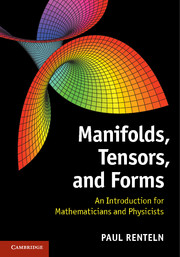Book contents
- Frontmatter
- Contents
- Preface
- 1 Linear algebra
- 2 Multilinear algebra
- 3 Differentiation on manifolds
- 4 Homotopy and de Rham cohomology
- 5 Elementary homology theory
- 6 Integration on manifolds
- 7 Vector bundles
- 8 Geometric manifolds
- 9 The degree of a smooth map
- Appendix A Mathematical background
- Appendix B The spectral theorem
- Appendix C Orientations and top-dimensional forms
- Appendix D Riemann normal coordinates
- Appendix E Holonomy of an infinitesimal loop
- Appendix F Frobenius' theorem
- Appendix G The topology of electrical circuits
- Appendix H Intrinsic and extrinsic curvature
- References
- Index
8 - Geometric manifolds
Published online by Cambridge University Press: 05 June 2014
- Frontmatter
- Contents
- Preface
- 1 Linear algebra
- 2 Multilinear algebra
- 3 Differentiation on manifolds
- 4 Homotopy and de Rham cohomology
- 5 Elementary homology theory
- 6 Integration on manifolds
- 7 Vector bundles
- 8 Geometric manifolds
- 9 The degree of a smooth map
- Appendix A Mathematical background
- Appendix B The spectral theorem
- Appendix C Orientations and top-dimensional forms
- Appendix D Riemann normal coordinates
- Appendix E Holonomy of an infinitesimal loop
- Appendix F Frobenius' theorem
- Appendix G The topology of electrical circuits
- Appendix H Intrinsic and extrinsic curvature
- References
- Index
Summary
Une géométrie ne peut pas être plus vraie qu'une autre; elle peut seulement être plus commode. (One geometry cannot be more true than another; it can only be more convenient.)
Henri Poincaré, La science et l'hypothèseAs we have seen, a differentiable or smooth manifold M is just a topological space on which we have the ability to differentiate stuff. This is adequate if one is interested only in differential topology, but to do more we need to introduce additional structure. This additional structure is a geometry. Basically, we want to be able to measure distances on M as well as determine the angles between vectors. Of course, the vectors don't live on M – they live on the tangent spaces to M. What we need is an inner product on the tangent spaces. But we want to be able to differentiate things, so we want the inner product to vary smoothly.
This leads us to the following definition. A smooth inner product or metricg on M is just a smooth map p ↦ gp, where gp is an inner product on TpM. A geometric manifold(M, g) is a manifold M equipped with a smooth inner product g. Two geometric manifolds (M, g) and (N, h) are considered equivalent if they are isometric, meaning there exists a diffeomorphism φ : M → N with φ*g = h.
- Type
- Chapter
- Information
- Manifolds, Tensors, and FormsAn Introduction for Mathematicians and Physicists, pp. 193 - 248Publisher: Cambridge University PressPrint publication year: 2013



